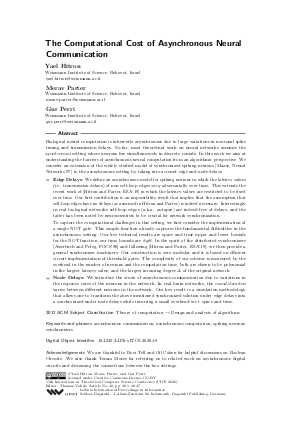LIPIcs.ITCS.2020.48.pdf
- Filesize: 2.15 MB
- 47 pages

 Creative Commons Attribution 3.0 Unported license
Creative Commons Attribution 3.0 Unported license

Biological neural computation is inherently asynchronous due to large variations in neuronal spike timing and transmission delays. So-far, most theoretical work on neural networks assumes the synchronous setting where neurons fire simultaneously in discrete rounds. In this work we aim at understanding the barriers of asynchronous neural computation from an algorithmic perspective. We consider an extension of the widely studied model of synchronized spiking neurons [Maass, Neural Networks 97] to the asynchronous setting by taking into account edge and node delays. - Edge Delays: We define an asynchronous model for spiking neurons in which the latency values (i.e., transmission delays) of non self-loop edges vary adversarially over time. This extends the recent work of [Hitron and Parter, ESA'19] in which the latency values are restricted to be fixed over time. Our first contribution is an impossibility result that implies that the assumption that self-loop edges have no delays (as assumed in Hitron and Parter) is indeed necessary. Interestingly, in real biological networks self-loop edges (a.k.a. autapse) are indeed free of delays, and the latter has been noted by neuroscientists to be crucial for network synchronization. To capture the computational challenges in this setting, we first consider the implementation of a single NOT gate. This simple function already captures the fundamental difficulties in the asynchronous setting. Our key technical results are space and time upper and lower bounds for the NOT function, our time bounds are tight. In the spirit of the distributed synchronizers [Awerbuch and Peleg, FOCS'90] and following [Hitron and Parter, ESA'19], we then provide a general synchronizer machinery. Our construction is very modular and it is based on efficient circuit implementation of threshold gates. The complexity of our scheme is measured by the overhead in the number of neurons and the computation time, both are shown to be polynomial in the largest latency value, and the largest incoming degree Δ of the original network. - Node Delays: We introduce the study of asynchronous communication due to variations in the response rates of the neurons in the network. In real brain networks, the round duration varies between different neurons in the network. Our key result is a simulation methodology that allows one to transform the above mentioned synchronized solution under edge delays into a synchronized under node delays while incurring a small overhead w.r.t space and time.
































Feedback for Dagstuhl Publishing